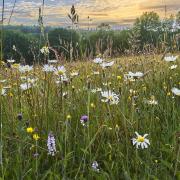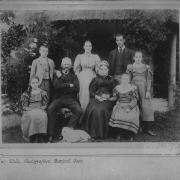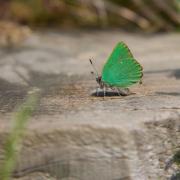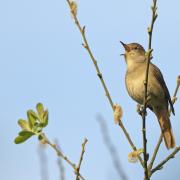March is a mad time, of leaping hares and the bursting through of golden, sunshiny flowers as the earth wakes up after its winter sleep.
Celandines, daffodils, and primroses are already out and adding a touch of sunshine even if the real sun isn’t shining and we have March winds instead! Celandines are known as ‘brighteye’, ‘cheesecups’, ‘butter and cheese’, ‘golden guinea’, and other cheerful names. In the Victorian language of flowers, the celandine means ‘joy to come’ or the ‘first sigh of love’, appropriate springtime meanings. Daffodils, one of the flowers of Wales, are out on St David’s Day on 1 March. They are also known as ‘Lent-lilies or ‘Lent-cocks’, the latter linked to the nasty blood sport of cock throwing, that is, throwing weighted sticks at cockerels. By the end of the 18th century, the tradition was being forgotten and boys would throw the sticks at daffodils instead.

RARE COTSWOLD BLOOMS
Today we see daffodils mainly in parks and gardens and planted along road verges, but once they were everywhere as a wildflower. Gloucestershire has one of the largest concentrations of the wild daffodil up on the county’s northern edge at Dymock and Kempley.

That other now rare March bloom, the snake’s head fritillary, occupies meadows near Cricklade but, like the wild daffodil, was picked almost to obliteration with the coming of the railways. It is said to have not bowed its head during the crucifixion until an angel whispered to it and now it keeps it head bowed always in humility. As Easter is in March this year, this seems fitting, as does the derivation of the word ‘fritillary’, which means ‘dice box’, owing to its chequered surface. There was dicing at the crucifixion, too. More innocently, at Uley the men would hold their marbles competition on Good Friday, and at Dursley there would be games and hot cross buns. At Great Rissington on Good Friday people went picking the last of our trio of sunshine yellow flowers, primroses. In the language of flowers, the primrose is the flower of childhood – but beware, for the ‘primrose path to dalliance’ in Shakespeare leads to early death and ‘the everlasting bonfire’.

The animal we think of most in March is, of course, the hare. Are you ‘haring along’ in our busy world or maybe feeling ‘hare-brained’ today? In Wiltshire, there’s a tale in which the hare gets the last laugh. Two young men up from town are sold a ‘mare’s egg’ by a country fellow. It’s large, round, and bright orange. The chap says it’s the egg of a thoroughbred mare and will produce a fleet foal. He names an eye-watering price. The townsmen gingerly carry away their prize, but, while they’re running to catch their train, disaster strikes! The ‘egg’ falls to the ground and splits, and they see a hare running away across the field. Too fast for them! They return to London empty-handed and completely fooled, saying, ‘If it was that fast as a little baby, how fast would it have been on the track?’ And the egg? I fear it was a pumpkin.
There’s long been a link between those perceived to be witches and hares. It’s said that a witch can go into a hare, and see from its eyes, and then come back out again, their own self. The tradition is that it’s an old woman who does this. And why shouldn’t an old woman enjoy the mad dance of youth once more? In 1649 a woman from near Tewkesbury was tried as a witch because it was said that she went into a polecat and stole sow’s milk.

A FLAXLEY LOVE AFFAIR
In Flaxley in the Forest of Dean, there’s a rather different story. There was once a young man and a young woman who fell in love – a thing as natural as the spring. She lived on the Elton Road where it comes into Flaxley, and he just a few doors away. They say his family were Welsh, and maybe that was the trouble, or maybe there was a question of how he would support her – or maybe her father was just cussed – because he wouldn’t allow them to even meet, let alone marry.
He built a wall around his house, and his daughter had to stay within its bounds at all times. I’m not sure he even let her go to church, though it was only a step down the road to the fancy new church that had been built just a few years before. Every time the young man went past, he gave the father a cheery wave. The father thought to himself that the lad seemed happy enough. He also observed that his daughter wasn’t too upset, and he thought complacently that he had solved the matter.

Then, one Sunday, as he saw the young man pass by with his cheery wave the father happened to keep on watching him. As the young man turned the corner into the village, out of sight, so a hare leapt over the garden wall and started nibbling at the grass near the well! And here was his daughter, just heading out to get water from that well… Something clicked in the father’s head. He raced inside for his shotgun and took a potshot at the hare. The shot hit the animal a glancing blow on the leg and it bounded away in fright. After a while the church bells rang out and there was the young man coming back along the road, and he was limping…

That wasn’t the end of the story. The daughter was so furious that she forced her father’s hand and she married her young man. But the real question is: how did he learn to become a hare? Or rather, who taught him? Another tale from the Forest district tells of a girl who, on her way to market in Gloucester, saw a hare racing round in circles in the pre-morning dew – perhaps at Westbury-on-Severn. As it did, she heard the blart of a hunting horn, and the hare leapt into her bag. The hunt came galloping into the field, and right at their head was the Devil himself, asking for the hare.
The girl didn’t have to think. She said no hare had passed by. As the dawn came, the huntsmen rode away and the hare peeked out of her bag and then told her that she was a wise woman who’d been condemned at her death to run as hare with the Devil and his huntsmen chasing her. If he caught her, it was hellfire and damnation, but if she saw the Devil’s hellhounds running away from her in the dawn, well, she’d be going to another, better, place, where hares and women both were as free as the birds. Could she be the one who, perhaps later in her life, taught that young man how to go into a hare? Who knows? But we’d be mad as March hares to question it.
ESSENTIALS
Places to visit: Flaxley and Westbury-on-Severn – and a nice walk can be done between the two. Dymock and Kempley for daffodils. North Meadow, Cricklade, for snake’s head fritillaries if it’s open to visitors.
Refreshments: Lyon Inn, Westbury-on-Severn
Further reading: Gloucestershire Folk Tales for Children, by Anthony Nanson and Kirsty Hartsiotis; Wiltshire Folk Tales, by Kirsty Hartsiotis; The Folklore of Gloucestershire, by Roy Palmer; The Leaping Hare, by George Ewart Evans and David Thomson.
LINKS
Kempley Daffodil Weekend, March 16 & 17: daffs.org.uk
Daffodil Weekend and Spring Fayre, Dymock, March 30 & 31: dymockparishhall.co.uk/blog/posts/63
North Meadow, Cricklade: visitwiltshire.co.uk
Kirsty Hartsiotis is based in Stroud and available for hire as a storyteller and speaker. She is an accredited Arts Society lecturer. Her books include Wiltshire Folk Tales and (with Anthony Nanson) Gloucestershire Ghost Tales and Gloucestershire Folk Tales for Children. She is also a curator at Swindon Museums.



























